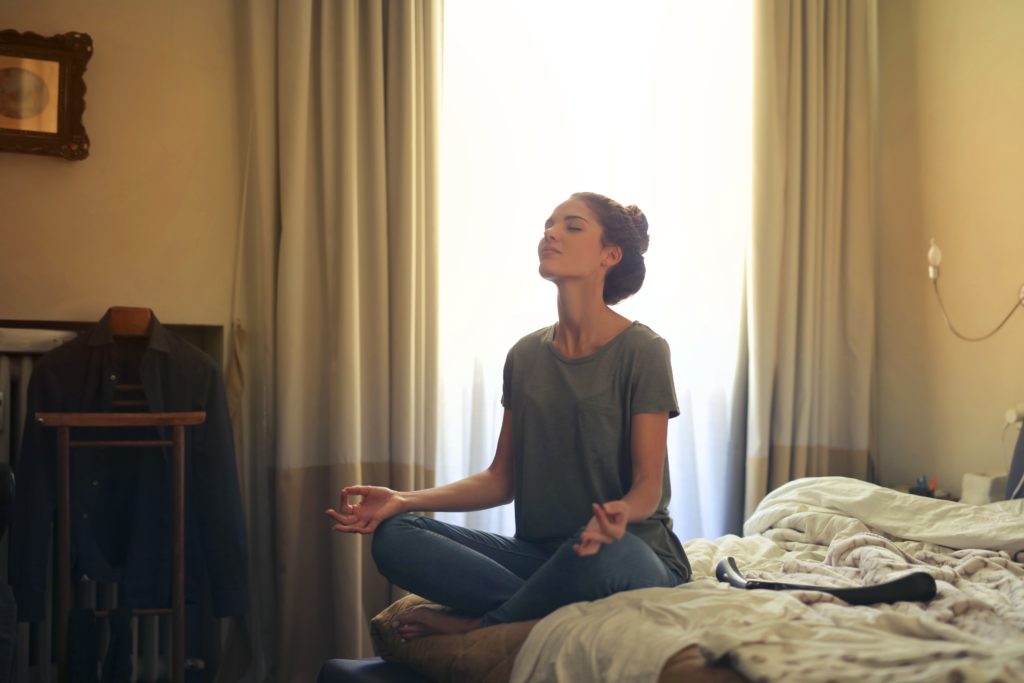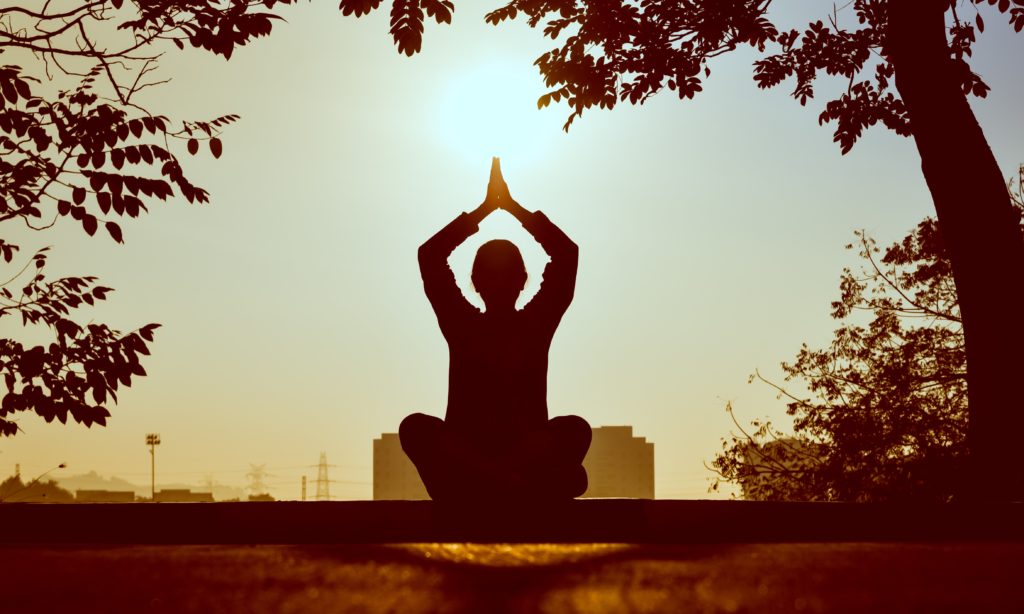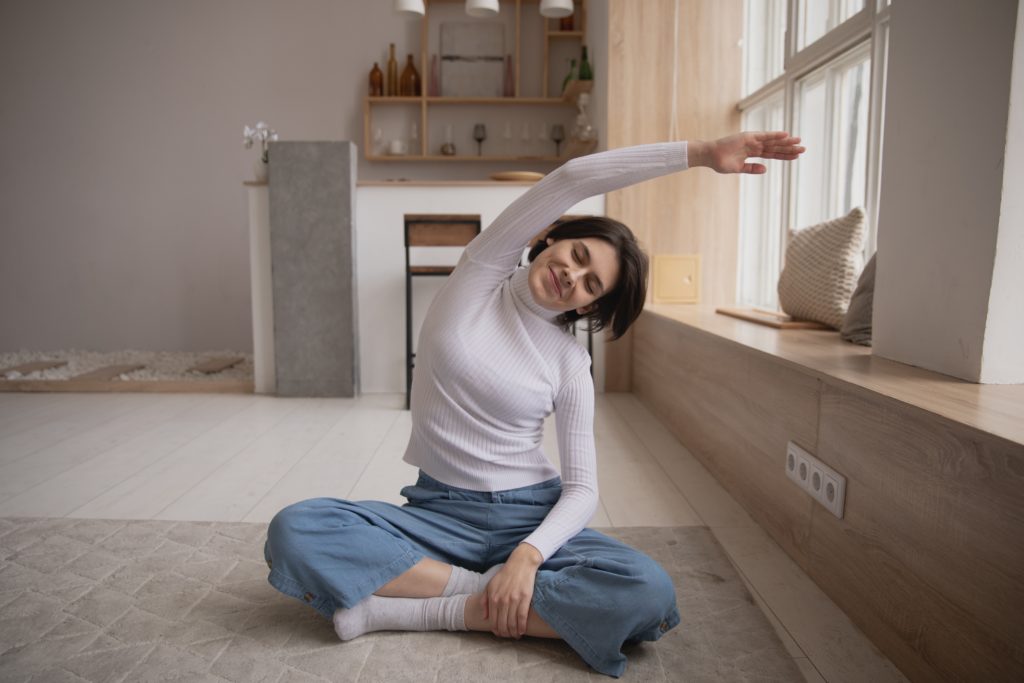Evolve > Mindfulness >14 Different Meditation Techniques You Can Try
“True meditation is sitting open to whatever is happening – pleasant or unpleasant.” – Adyashanti
There is no right or wrong way to meditate. You practice meditation to the form that suits you best and works for you. There are so many different types of meditation techniques to choose from, so you can pick what is comfortable. Each meditation technique is slightly different in its own way, but the core practice remains the same. Connecting with your mind and body, attaining balance and a sense of calm.

Here are 14 different meditation techniques you can try
- Focused attention meditation. This is a type of meditation where you focus your attention on a specific thought, object or breath during your meditation. You focus on it and stay fully in the moment with that object. Over time, your mind will become calmer and clearer, distractions will be forgotten and you’ll be able to keep your flow. As a result, you feel more relaxed and balanced.
- Mindfulness meditation. A meditation technique where you focus all your attention in the present moment. You can practice mindfulness wherever you are, be it on a park bench, on your work desk or while travelling. It involves tuning out everything and focusing your breathing. Get comfortable wherever you are, being seated is optional. Start focusing your breath and pay attention to it closely. As you breathe, allow thoughts to come and go and keep bringing your attention to the present moment. If your mind wanders, give it a few seconds, and slowly bring your attention back to your breath. The idea behind this meditation technique is to not add anything to your current experience, but understanding and enjoying it to the fullest. Moreover, learn more about 5 meditation practices to cultivate mindfulness!
- Gratitude meditation. One of the simplest meditation techniques where you express gratitude in the moment and feel grateful. Gratitude meditation is an effective way to boost your mood and create a happy state for your mind and body. You focus your emotions on sending a compliment or positive thoughts to someone you care for and allow yourself to feel the positive energy flow within you. Furthermore, it can be done within minutes and it is a great way to balance yourself anytime you feel stressed or anxious or as part of your daily meditation routine. Learn more about gratitude meditation here.
- Zen meditation. A Buddhist meditation technique, also called seated meditation. It involves sitting on a chair or on the floor, while you face the ground. To practice it, you focus on your breath and stay fully focused on the nature and rhythm of your breath, counting every inhale and exhale. As you breathe, you allow thoughts to come and go and experience the moment. If your mind starts to wander, you bring your attention back to your breath.
- Vipassana meditation. Another Buddhist meditation technique, it means “clear seeing”. It is a type of open monitoring meditation, but it starts with mindfulness via your breath. When you practice, focus all your attention on your breath. Every deep breath in and out. Slowly, start to notice how your body and mind responds to the breathing. Notice your chest and abdomen rise and fall with every breath and how the air fills up your lungs and how it touches your nostrils. Allow thoughts to come and go, acknowledging them without judgement. The core idea of this meditation technique to make your breathing the hero and everything else around you fades into the background.
- Loving kindness meditation. Another one of the simpler meditation techniques is also known as metta meditation. It includes spreading love and kindness through your mind and body as you meditate. However, once you start, it takes its own turn. You start by developing loving-kindness towards yourself, complimenting yourself and being positive. Then slowly moving towards others you know and all other beings in the world. Start with yourself, then focus that love and kindness towards those you know and don’t know and then everyone and everything in the universe.The feeling of wishing happiness and well-being for all translates to good wishes and feelings for you.
- Mantra meditation. A mantra is a syllable or word, usually without any particular meaning, that is repeated for the purpose of focusing your mind. Meditation practice by repeating a particular mantra can be very therapeutic and good for your mind and body. Mantras have been popular in many religions and traditions. Hindu traditions, Buddhist traditions , as well as in Sikhism and Jainism are some religions in which mantra meditations and mantras in general are very common. It is also known as om meditation, after a popular mantra. You repeat the mantra in your mind silently, repeating it during the entire duration of your meditation. A good way to make the meditation effective is to coordinate the mantra with your breath and focus on it as you recite your mantra. You may practice for a certain period of time, or for a set number of “repetitions”, by repeating the mantra for a set number of times, usually 108 times in order to complete a meditation cycle.
- Transcendental meditation (TM). Transcendental Meditation is a specific form of Mantra Meditation introduced by Maharishi Mahesh Yogi in 1955 in India and the West. It’s one of the most popular meditation techniques. In the late 1960s and early 1970s, the Maharishi achieved fame as the guru to the Beatles, The Beach Boys and even today, many celebrities including Eva Mendes practice TM. While you cannot practice it without signing up to learn it from a licensed instructor, it is known that TM involves the use of a mantra. You sit down and practice it for 15-20 minutes, twice a day and keep your eyes closed. You can choose your own mantra and they are usually names of Hindu deities.
- Chakra meditation. It’s a type of Yogic meditation, which focuses on your conduct, physical posture and breathing exercise. In this meditation, you focus on one of your seven chakras or energy centres. You usually practice visualisations and chant a specific mantra for each different chakra. The seven chakras are:
- the root chakra, at the base of your spine – Muladhara
- the sacral chakra, which is three inches below your navel – Swadhisthana
- the solar plexus, which is near your gut – Manipura
- the heart – Anahata
- the throat – Vishuddha
- the third eye chakra located between your eyebrows -Vishuddha
- the crown, located on top of your head – Sahasrara

10. Gazing meditation. This meditation technique involves fixing your gaze on an external object, typically a candle, image or anything around you. Practice it with eyes open, and then with eyes closed, to train both the concentration and visualization powers of the mind. After closing the eyes, you should still keep the image of the object in your focus and pay attention to it for the duration of the meditation. As a result, this meditation can help you increase your focus and reduce anxiety.
11. Body scan meditation. One of the meditation techniques that utilities your entire body. This body scan meditation involves scanning your entire body from head to toe and notice all the sensations at each body part and acknowledging it. This helps release tension, allows your body to switch off and relax. Hence, you can practice it by lying down in a comfortable position, focusing your attention on toes and gradually moving up to your legs, thighs, stomach all the way up to your head. As a result, you can notice any stress and release tension!

12. Sound meditation. This meditation involves focusing on sound. You start your meditation by focusing on external sounds like calming music and other ambient tones. You use it to help quieten your mind and collect your thoughts. As you get deeper into your mind and focus on continuing to quieten it, your internal sounds will become clear and loud. You can then focus on those sounds within your body and mind to attain a place of balance and peace. In this meditation, the ultimate goal is to hear the “ultimate sound”, which is a sound having no vibration.
13. Emptiness meditation. Emptiness meditation is a form of Chinese meditation. It involves sitting quietly and emptying yourself of all mental facets incuding images, thoughts and feelings to “forget about everything”. This is done in order to experience inner quiet and peace. While practicing this, you allow thoughts and sensations to come and go on their own, without reacting and indulging any of them.
14. Breathing meditation. This is a meditation technique where you do a particular breathing exercise or technique in order to meditate. Breathing is a powerful tool and can help you reduce stress, anxiety and help you sleep better. As a result, you can balance your body and mind and regulate your system by breathing. Moreover, it makes for a good break from work or the middle of your day. As a result, giving you a small dose of mindfulness. Popular breathing techniques include box breathing, belly breathing and 4-7-8 breathing.
Meditation has many benefits, it’s easy to practice and you can allow yourself to meditate for focus, to reduce stress, improve sleep or any other objective of your choice. Meditation and mindfulness are about staying in the present moment, feeling relaxed and allowing your body and mind to have balance. Any of these meditation can be practiced on your own, or as a guided meditation.
At Evolve, we believe mindfulness and mediation need not be serious and intense, but light and refreshing. It can be a part of your daily activities and become a way of living. We have a range of 50+ guided audios that are catered to your daily schedule so you can incorporate 5 minutes of mindfulness and meditation into your day, and practice it anytime, anywhere.
The Evolve app is now live globally on Android & Apple, click here to try for free!
With over 300 articles published on Evolve. Jash is one of the most viewed writers on topics such as Sleep, Mindfulness and Stress. Drop a mail at Jash@evolveinc.in to connect with him.